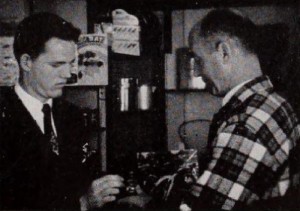
"May Day Conflict is a well executed and skillfully edited family story film of the conflict created by the opening of the trout season and a flower festival both falling on May first. The central character is a good loser (the husband, of course!), as he accompanies his wife to the flower show after elaborate preparations for his fishing trip. Herbert F. Sturdy has deftly woven into the story pattern light, humorous incidents to provide amusing comedy relief from his fine floral closeup studies. Expert camera handling and smooth transitions lend a semi-professional finish to the picture." Movie Makers, Dec. 1948, 493-494.
Travelogue of Rothenburg, Germany.
"The film, titled 'Memories of the New York World's Fair' by filmmaker Frank J. Pezzano documents the 1939-1940 New York World's Fair. Pezzano edited the film and included hand-drawn and typed intertitles identifying the various locations and activities he filmed." Archives Center, National Museum of American History.

"It takes Cal Duncan 1300 feet of 16mm. color film to tell a pair of politely uninterested guests how he caught a sailfish off Acapulco — but the effort, as exemplified in Mexican Malarkey, is decidedly worth it. Mr. Duncan's running gag, climaxed by a truly comic finish right out of the funny papers, is the flashback technique developed to a high and satisfying order. His Mexican footage itself is no less effective. The robust and hearty producer has an artist's eye for fresh viewpoints, a dramatist's instinct for revealing action. His sequence on Mexico's traditional Sunday bullfight, always a difficult assignment, is outstanding. Mexican Malarkey is a refreshing variation on an increasing wellworn theme." Movie Makers, Dec. 1949, 454.

"Having forsaken the good land of tequila for the gypsy life of a trailerite, Ralph E. Gray presents what may be the last in a long line of distinguished human record films on America's southern neighbor. Mexico At Work And At Play displays recurrently in its many and varied sequences the opulent camera work and warm eye for color which have marked all of Mr. Gray's award winners. Mirrored in the present movie are such native occupations as sugar cane farming and mescal distilling, such handicrafts as glass blowing and opal polishing, such diversions as cock fighting and an Easter Passion Play. Mr. Gray's treatment of these and other colorful subjects is leisurely, loving and methodical." Movie Makers, Dec. 1948, 494.

"General scenes around Acapulco; Bay, ships, beach, poolside, city scenes, landscape, cliff diving, traditional dance and crafts." UC San Diego Library.

"What would have been an excellent film under any circumstances becomes outstanding as a group production. Produced by the Minneapolis Cine Club, it was originally conceived by William S. Block, carried out under the supervision of G. L. Larson, with Earle E. Ibberson in charge of production, while club president Elmer W. Albinson did the final cutting and editing. All members contributed directly to the project, either in filming or by helping to complete the picture. In the film we accompany two teen-agers, a 4-H boy and girl, on a grand tour of the fair, visiting exhibits, marvelling at the livestock show,standing pop-eyed before the midway spectacles, puzzling over the complexities of modern art, gasping at the fireworks display against the night sky. A running gag furnishes comedy relief, while the wholesome charm of our young guides is revealed in a sympathetic and appealing fashion. The members' filming is consistently competent, and deft editing has made Minnesota State Fair a well integrated and thoroughly enjoyable entertainment." Movie Makers, Dec. 1948, 476, 491.
"Made by F. D. Koehler, jr., ACL, The Mississauga Canoe Trip is a fine example of what the movie maker can accomplish on a hunting trip in capturing a picture that has both good photography and an interesting story presentation. The fact that a tripod was added to the duffel did not daunt this cinematic hunter, and the result is refreshingly rock steady pictures that leave nothing to be desired. Perfect exposure, for the most part, and some excellent lighting show that the maker had an eye for the essentials of good picture making. A knowledge of what makes a good screen picture is demonstrated in the many effective closeups throughout the film. An excellent job of amateur titling is another feature that places this film in a high category for vacation films." Movie Makers, Dec. 1934, 534.
"This film shows Ojibwe women at Squaw Point, Leech Lake tanning hides and making moccasins decorated with beadwork and an Arikara or Hidatsa woman at Fort Berthold, North Dakota tanning cow hide and doing quillwork on clothing." Minnesota Historical Society.

"Frank E. Gunnell has used a novel continuity motif in Mohawk Pals that ties together what otherwise would be a rambling film story. Two boys are shown doing their "homework," and the final assignment is to write a composition on vacations. The film then pictures the summer adventures at Lake Mohawk of the two boys and a girl of similar age. From time to time, there are inserted shots of the boys writing, and sentences from their compositions are cleverly double exposed at the bottom of the frame, to serve as subtitles for the film. The cinematography is immaculate, and the youngsters appear without self consciousness in their various pursuits of fun on a summer vacation." Movie Makers, Dec. 1944, 496.
Total Pages: 14